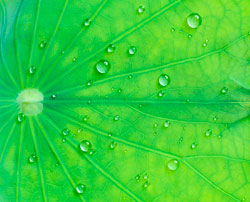A surface that can switch between superhydrophobic and superhydrophillic could have important medical implications, claim scientists in Greece.
Although a relatively new phenomenon, surfaces that switch between hydrophobic and hydrophilic behaviour depending on appropriate external stimuli have already gained attention due to their potential applications in microfluidic devices and cell adhesion. However, existing surfaces that respond to pH are hydrophobic at low pH and hydrophilic at high pH. This limits their use in many medical applications because at high pH the material is anionic and so does not allow interaction with other anionic molecules, such as DNA and enzymes.
Now, Spiros Anastasiadis and his team at the Institute of Electronic Structure and Laser, Crete, have successfully created a surface that is not only highly superhydrophobic and hydrophilic, but also demonstrates the opposite behaviour to currently known surfaces. They achieved this by grafting a pH responsive polymer (PDPAEMA) to a dual-scale roughened substrate and, in doing so, have also shown the importance of the substrate in creating excellent superhydrophobic surfaces.

The surface switches between superhydrophobic and superhydrophillic on changing pH
|
Critically, this superhydrophilic surface can interact with important anionic biological molecules in the hydrophilic state, potentially opening up new applications. 'One thing you would like to do is have a surface that can absorb DNA or enzymes and then, under different conditions, release this material,' explains Spiros. 'In our case, when it is positively charged, it is hydrophilic, so it can interact with negatively charged molecules, like DNA. When it is not charged, it is hydrophobic.'
Susan Perkin, an expert in surface chemistry at University College London, UK, recognises the potential for medical uses, but is particularly enthusiastic about the contact angles of the surface, saying that 'this is an example of a very dramatic change in the wetting behaviour just by changing the pH.'
Following this work, the authors are looking to optimise the polymer used and to make surfaces that are either superhydrophilic or superhydrophobic depending on the wavelength of light used to illuminate it.
Yuandi Li
Enjoy this story? Spread the word using the 'tools' menu on the left or add a comment to the Chemistry World blog.




